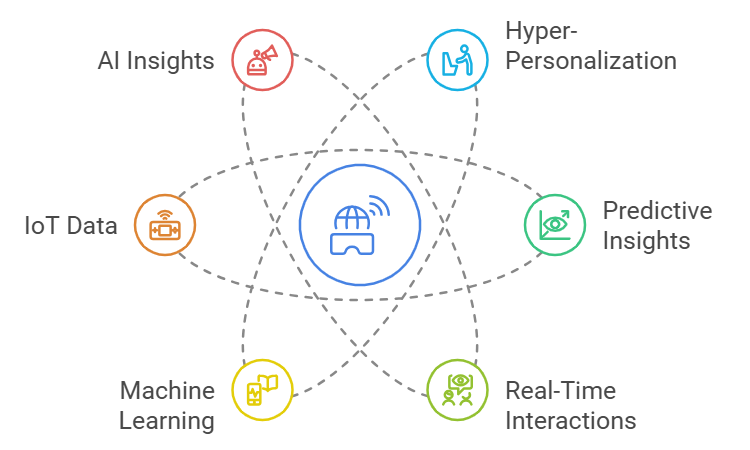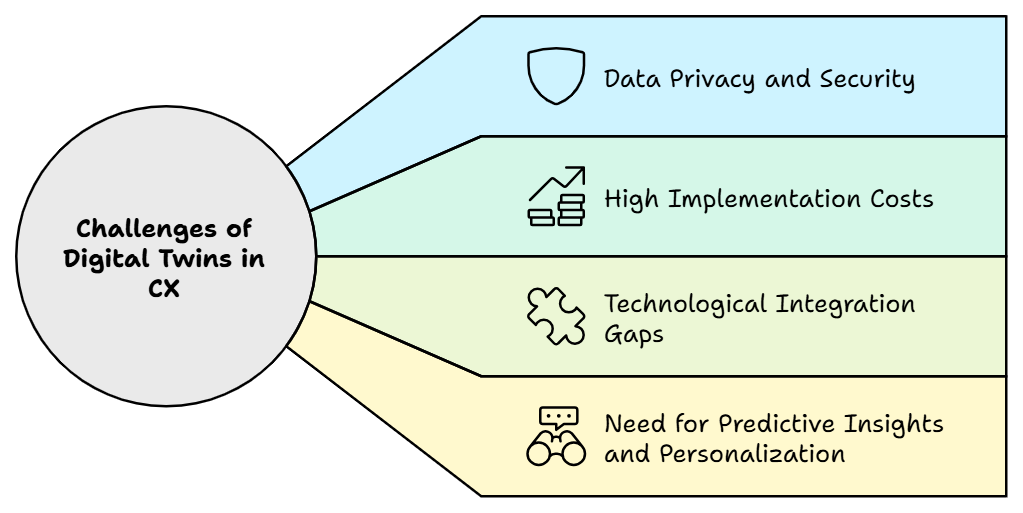Digital Twins: Transforming Customer Experience in 2024

Digital twins, virtual models that mirror physical assets or systems, are reshaping customer experiences across industries. These advanced digital replicas gather real-time data from IoT and AI technologies, enabling hyper-personalization and predictive capabilities. Already, sectors like manufacturing, healthcare, and urban planning leverage digital twins to streamline operations, improve efficiencies, and enhance decision-making. Now, they’re also poised to revolutionize customer experience (CX), especially as businesses seek more personalized and predictive interactions. From virtual fitting rooms in retail to smart city infrastructures that adapt to resident needs, digital twins are redefining the future of CX. In a market where personalization is key, digital twins offer an edge, driving loyalty and competitive advantage.
The Role of Digital Twins in Customer Experience

Digital twins enhance customer experience (CX) via real-time simulations that replicate and analyze customer interactions with products to anticipate their requirements. Digital twins leverage sophisticated AI and IoT tech to create feedback loops that empower brands with the deep, live data-refined insights needed to personalize CX. Hyper-personalization can be as simple as virtual fitting rooms in retail, and predictive customer support in automotive sectors.
Industries such as retail, healthcare, automotive, and smart cities are embracing the power of digital twins for CX in real-world environments. Management must play a strategic role to ensure investment sustainability. With this technology, brands can offer personalized experiences by allowing users to select the kind of shopping experience they want on their preferred platform while providing immediate customer support. In smart cities, for example, digital twins use citizen behavior patterns to fine-tune public services which improve Urban CX.
The future of customer experience with its predictive and personalization capabilities is digital twins. With the combination of AI and IoT, they enable enterprises to connect with customers in immersive, engaging ways for a better understanding of their consumers.
Benefits of Digital Twins for Enhancing Customer Experience

From hyper-personalization to predictive insights and improved real-time interactions, digital twins will reshape the customer experience. Digital twins enable businesses to track customer behavior and preferences so they can immediately render personalized recommendations and experiences that appeal to each consumer.
Machine learning-enabled digital twins prophesy, predicting and anticipating customer needs in the future. IoT data can, for example, monitor a device over time and report its need for maintenance or when it is nearing the end of its lifecycle based on usage patterns, leading to reduced downtime and improved satisfaction.
Digital twins also aid in real-time problem-solving. When you have AI insights, your support teams can quickly push tickets through the workflow and respond to customers faster than ever before, making them trust your brand more. Digital twins have an integral role to play in delivering a customized, insightful, and agile customer experience.
The Technological Backbone of Digital Twins
IoT and AI combine to support the creation of digital twins. IoT devices capture live data and make it possible to build digital twin systems in structures like smart houses or autos. In smart cities, sensors often track traffic as well as other environmental factors that assist future urban design and services.
Artificial intelligence and machine learning complement the existing features of the digital twins by processing information for forecasting and creating an ultra-personalized experience. The AI analyzes the structures of models of the digital twin to make recommendations to clients or anticipate their actions. With virtual fitting rooms, retailers analyze customer behavior and provide recommendations, increasing client satisfaction and sales. The evolution of IoT and AI is exemplary in applying customer experience concepts in smart cities, predictive maintenance, and personalized content.
Case Studies of Digital Twins Revolutionizing Customer Experience
In the retail sector, Digital twins are changing the way customers engage with brands in the retail industry. Companies like Amazon and Nike allow their customers to use virtual fitting rooms where they can put the clothes and shoes in a more digital space. This also provides customers with a better experience since customers can engage in a more personal and interactive shopping experience in the comforts of their own homes.
In the automotive industry, Tesla and BMW also use digital twins to allow their customers to virtually test drive or take a virtual tour of the car. These allow for a far more realistic preview of cars that may help seek out potential buyers to be more interested in purchasing the vehicle.
In Texas, the heart of the healthcare industry, patients' digital twins are changing the shape of the paradigm of personalized medicine that has emerged in recent years. By predicting treatment and its effect, a virtual model utilizing these possibilities provides an opportunity to customize care for patients improving results.
The movement of Hyper personalization through the three elements of IoT technology, AI, and Predictive elements has unleashed the curtain to the future of customer experience in various industries. Digital twins are not simply a fad; they are enhancing how businesses interact with their consumers. Integrating the technology will allow for a much more enhanced experience.
Challenges in Implementing Digital Twins for CX

The use of digital twins for optimizing customer experience (CX) is not without its issues, particularly with regard to data privacy and security. The virtual twins have to use the sensitive data of the customers to make the replicas which is highly questionable on the account of privacy. This data needs to be protected which involves certain cyber security measures which are very crucial and add to the complexity and cost of implementation. The initial costs are also a barrier to the adoption; funds have to be put into machines, infrastructure, and manpower which makes the digital twins a costly affair as an enhancement of solution to CX.
Further, gaps related to the provision of technology are common. For effective forecasting and hyper-personalization, seamless integration of IoT devices, AI, and other platforms comes with the use of digital twins, which require correct and precise data. In their absence, it seems almost impossible to conceive of real virtual experiences such as virtual fitting rooms or smart city interfaces.
Of course, digital twins are the way to go when it comes to customer experiences by providing the customers with predictive insights and offering a high level of personalization but these challenges will have to be addressed in order to ensure longevity.
The Future of Digital Twins and Customer Experience
The future of digital twins in customer experience is poised to reshape industries, with expansion into travel, entertainment, and education. As businesses in these sectors adopt digital twins, they can deliver personalized, immersive experiences. For example, virtual fitting rooms for travel gear or interactive museum tours will elevate user engagement.
Technological advancements in AI, cloud computing, and IoT will drive digital twin adoption, making it accessible for businesses of all sizes. These advancements enable real-time data processing and predictive capabilities, which will refine customer experience strategies through personalization and automation.
Long-term, digital twins will drive trends in hyper-personalization, allowing businesses to predict and adapt to customer needs with unprecedented accuracy. From smart cities to virtual customer service agents, digital twins can enhance predictive and proactive customer service, setting a new standard in customer experience.
This evolution in customer experience underscores the transformative potential of digital twins, paving the way for hyper-personalized, data-driven CX solutions.
In summary, Digital twins are transforming the future of customer experience by offering unprecedented levels of personalization, predictive capabilities, and real-time interactions. Through the integration of IoT and AI, businesses can create hyper-personalized experiences, from virtual fitting rooms to smart city innovations. The predictive power of digital twins enables brands to anticipate customer needs, enhancing satisfaction and loyalty. As digital twin technologies continue to evolve, companies must explore these innovations to stay competitive and elevate their customer experience strategies. Embrace the future with digital twins and unlock the potential of next-gen customer experiences.
Be at the forefront of technological innovation! Join our vibrant community to unlock expert insights, exclusive content, and the latest news on AI, IoT, and cutting-edge retail solutions. Stay informed, get inspired, and be part of the conversation—subscribe digitalexperience.live today for your gateway to the future!
FAQs:
1. What is the future of digital twin technology?
The future of digital twins is exciting! With AI and IoT, they’ll drive smarter, more personalized experiences, predict customer needs, and enhance real-time decision-making across industries.
2. How does digital transformation improve customer experience?
Digital transformation boosts customer experience by enabling hyper-personalization, using AI and data to create faster, smarter, and more tailored interactions that meet customer expectations.
3. What is a digital twin of the customer?
A digital twin of the customer is a virtual replica of a person, created from their data and interactions. It helps businesses deliver super personalized experiences that feel tailor-made.
4. What will be the customer experience in 2030?
In 2030, the future of customer experience will be shaped by AI, digital twins, and immersive tech. Expect hyper-personalized services that are fast, intuitive, and seamless across all platforms.



